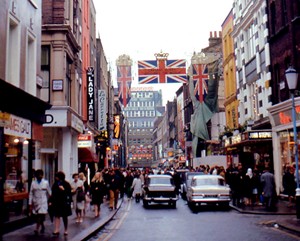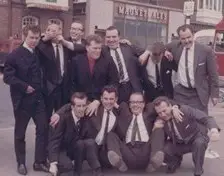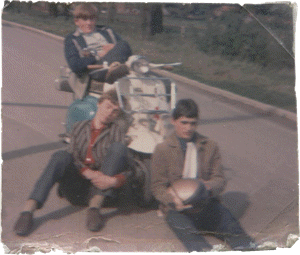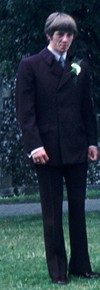Men's fashion in the 1960s - UK

Image by Roger W licensed and distributed under CC BY-SA 2.0 (cropped).
Introduction
Men's fashion changed enormously in the 1960s. At the start of the decade the look was a suit or sports jacket with tapered trousers and turn-ups. Younger men started wearing denim jeans in the 1950s. By the end of the decade, it was bright shirts and ties. Denim was much more common. But for office jobs and formal occasions, the suit was still a requirement.
John Stephen opened his first shop in the environs of Carnaby Street in the late 1950s. He catered to the growing Mod movement. Groups such as The Who, The Small Faces and The Kinks popularised the style.
In the second half of the 1960s, young people discovered the past. They looked for Victorian and Edwardian military uniforms in 'I Was Lord Kitchener's Valet' in Portobello Road.
Change came at the end of the decade. The hippy style, beads, kaftans and long hair, replaced Mod fashion. The style reached its peak in the Summer of 1967, but continued to influence fashion into the 1970s.
Young people tried unisex clothes in the late 1960s. The older generation complained that it was difficult to tell the sexes apart. The universal legacy of the 60s was the jeans and T-shirt combo, worn by both men and women.
This fast pace of change was only for the young. Teenagers leaving school at fifteen had money to spend on music and clothes. They often married by their early twenties. This period of freedom was short-lived.
Television programmes, Ready, Steady Go and Top of the Pops, spread the new style throughout the country. But different regions and different generations moved at different speeds. Some did not adopt the same styles. Working-class youths in the late 1960s saw nothing for them in the hippy style and went to the opposite extreme. The Skinhead movement derived from the Mod style of the mid-sixties. It added ultra-short haircuts. Rather than a constant changing look, it was a uniform.

Detail: Winklepickers
Winklepickers were sharp shoes. They had a pointed toe. They were popular mainstream fashion for young men in the early 1960s. The pointed toe was also fashionable for young women's shoes.
Older people also tended to be slower to adopt new styles and there was a marked generation gap in the 1960s.
Early 60s men's fashion
Fashion was still regional in the 1960s. Styles from London took time to reach the whole country. The film 'Kes' (1969) is about Billy, a boy growing up in Barnsley in Yorkshire. His older brother, Jud, still wears this style right down to the winklepickers. In the early 60s, the Teddy Boy style was still in vogue in some towns. In London the Mod movement was starting.

For most men over thirty the smart suit remained the only way to dress for going out. Many went to tailors, such as Burton or John Collier at least once a year. Burton's suits were good value for money and lasted well.
Mid 60s men's fashion

The Mod style
The Mods of the early 1960s took the suit to new levels of style. The tapered trousers and thin lapels of the Italian style became a new youth cult in the early to mid-1960s. To this look they added striped blazers, Fred Perry shirts and the Mod scooter, a Lambretta if possible.
Carnaby Street was their fashion centre. John Stephen had several shops there. His male boutiques became the equivalent of Mary Quant's Bazaar.
In the mid-60s, the London Mods congregated in Carnaby Street for a regular fashion parade. Pop music poured from the boutiques and men's shops along the small, narrow street. The Mods brought their girlfriends with them.
Shops on Carnaby Street often came and went. Shops that were on Carnaby Street in the 1960s included:
Men's shops/male boutiques:
- John Stephen
- Lord John
- Adam W1
- Tre Camp
- Carna B Hive
- Paul's Male Boutique
- Domino Male
Carnaby Street also had a junk shop called Gear. It sold furniture from the Victorian past and reminders of the then fashionable Art Nouveaux era.
Also on Carnaby Street in 1967 were a couple of old fashioned pubs, a health food shop, a toyshop and Button Queen, which sold old buttons.
The antithesis of the Mods were the Rockers. They took their style cue from Marlon Brando in 'The Wild One' (1954). They were a throw back to the 1950s and early 1960s greaser look in America. Rockers preferred powerful motorbikes to Italian scooters. They wore black leather and black denims. Hair was greased and combed back in styles reminiscent of the Teddy Boys from the previous decade.
Naturally the two groups did not get on and fights between them made the front pages of the national press.
For more on Mods see Mods and Rockers and 60s Mods
Hippy style

Mod fashions were mainstream youth culture by 1965. In 1966 the scene changed. In January 1966, Nigel Waymouth opened Granny Takes a Trip at 488 King's Road, London. It was at the wrong end of the street, known as the World's End.
He ran the shop with his girlfriend, Sheila Cohen, a fan of vintage clothes, and former tailor, John Pearse. They decorated the shop with red Art Nouveaux lettering on a black background. It looked very dark and mysterious. Inside were Aubrey Beardsley prints and blow-ups of French postcards from the naughty nineties (the 1890s that is).
They sold clothes for both men and women.
Granny Takes a Trip marked the end of Mod and the beginning of Hippy style. It sold floral shirts, jackets with wide lapels, velvet and brocade flares and skirts and dresses in velvet and lace.
Granny's became a Mecca for the pop world. The Beatles, the Rolling Stones, the Animals and Pink Floyd were all customers.
Following on from Granny's, Hung On You had a shop front painted by pop artist, Michael English. He chose bold Art Deco inspired lettering in red over bright yellow sun rays on a black background. His timing was perfect for the late 1960s' Art Deco rival, which inspired Biba and films such as 'Bonnie and Clyde'.
Also in 1966, Michael Fish, opened his first shop 'Mr Fish' in Clifford Street. Michael Fish invented the kipper tie. He labelled his clothes 'Peculiar to Mr Fish'.
Bridging Mod and Hippy style was this smart, double-breasted style (above left). This was the way for a fashionable young man to look hip without being scruffy. Many of the Mod bands in the late 60s took up this style. They often combined it with elements of the Hippy style.

For mainstream youth fashion, everything changed again in the Summer of 1967. The smart look of the Mods gave way to long hair, beads, beards and kaftans. Flower power was in the air. The look was psychedelic swirls and paisley patterns. Full-on Flower Power was short-lived, but its influence was long-lasting.
1969 and after
At the end of the decade most hippies got proper jobs, but hairstyles for men remained long.
Working-class youths who disliked the hippy style opted for short-cropped hair and Dr Marten boots. The Skinhead was born.
Selected comments from people who remember
"The 60s were great times for mods I was living in peckham and used to dress in tonic mohair suits camel coats long leather coats. Also hush puppy shoes then raul shoes very italian.
Used to have my hair cut in a college boy cut or french crew cut. Used to wear brut after shave.
Go to brighton or margate for bank holidays on scooters. Also used to go to hastings all the girls loved you if you were from london and a mod. Used to go to the triangle at the end of peckham high street to meet all the other mods on scooters.
Great times anyone from peckham remember them there" j holden
"I loved it. I still have my Mr. Fish shirt & my jacket from Harrads Way In. Very switched on." Jeffrey Beuglet
"I now live in Australia but I was born in 1950 and lived through the sixties as a teenager in the Montpelier area of Bristol. Thanks to sites like this I can look back and realise what a wonderful time it was - for me everything was a first: First secondary school, first shave, first drink (Rum and black), first transport (Lambretta - what else?), first dance club (Locarno - what else?), first girlfriend, first love, first heartbreak, first job, etc - plus music and fashion changing around you. During the decade I went from Lonnie Donegan and Joe Brown and the Bruvvers to Cliff Richard, to The Beatles, to John Mayalls Bluesbreakers (with Eric Clapton), to The Incredible String Band (my hippie stage - the Hedgehog Song still haunts me!), to The Four Tops and The Temptations and everything Motown, to Prince Buster and Desmond Dekker and everything reggae. What an absolute blast - 10 years of total sensory and emotional overload!" Robin Trulock
Read more:
- Mods and Rockers
- 60s Mods
- 60s mens suit
- 60s fashion pictures
- Apache scarf
- 60s shirts
- 60s trousers
- 60s fashion - women
By Steven Braggs, December 2021


Comments